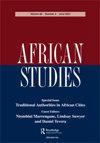Rereading Burying SM as a ‘Social Reproduction Text’
IF 0.9
4区 社会学
Q2 AREA STUDIES
引用次数: 0
Abstract
The lawyer Silvanus Otieno died in Nairobi in December 1986. His Luo relatives wished to bury him in his rural homeland of Siaya in accordance with what they held to be Luo custom. His wife, Wambui, who was Kikuyu, went to court to ask for permission to bury him at their urban home in Nairobi. The course of events can be briefly summarised as follows. On it becoming apparent, soon after his death, that his family and his clansmen differed as to the appropriate place to bury SM, as he was widely known, his widow sought an injunction in the High Court restraining the clan from removing his body from the Nairobi City Mortuary and a declaration that she was entitled to claim her husband’s body for burial at their farm in Ngong, near Nairobi. Her application succeeded. Upon the clan’s application, the Court of Appeal set aside the High Court ruling and ordered that the matter be set down for trial. The trial was conducted before Justice Bosire, who rendered his decision on Friday, 14 February 1987. He directed that the deceased’s body be handed over to the clan and the widow jointly or to either one separately, for burial in Siaya. The clan’s wishes were thus granted. Wambui appealed, the Court of Appeal delivering its judgment on 15 May 1987. It dismissed the appeal and ordered that SM be buried in Siaya in accordance with Luo custom. Commenting on the case, the author of a casebook on Kenyan customary law, Eugene Cotran, described the case as a landmark for customary law and in Kenyan legal history (Cotran 1989; for a discussion of the customary law aspects of the case see Manji 2002). In 1992, David William Cohen and E.S. Atieno Odhiambo published their study of the case under the title Burying SM: The Politics of Knowledge and the Sociology of Power in Kenya.重新解读SM作为“社会再生产文本”的埋葬
律师Silvanus Otieno于1986年12月在内罗毕去世。他的卢奥族亲戚希望按照他们所认为的卢奥族习俗,把他葬在他的家乡乡下的西亚亚。他的妻子万布伊(Wambui)是基库尤人,她向法院请求允许将他安葬在内罗毕的家中。事件的经过可以简单概括如下。在他死后不久,他的家人和他的部族显然在埋葬他的适当地点问题上存在分歧,因为他是众所周知的,他的遗孀向高等法院申请禁令,禁止部族将他的尸体从内罗毕市停尸房移走,并声明她有权要求将她丈夫的尸体安葬在内罗毕附近恩贡的农场。她的申请成功了。在氏族的申请下,上诉法院撤销了高等法院的裁决,并下令将此事进行审判。审判由Bosire法官进行,他于1987年2月14日星期五作出裁决。他指示将死者的遗体交给氏族和寡妇共同或分别,以便在西亚埋葬。氏族的愿望就这样实现了。Wambui提出上诉,上诉法院于1987年5月15日作出判决。法院驳回了上诉,并下令按照罗族习俗将SM埋葬在Siaya。肯尼亚习惯法案例手册的作者Eugene Cotran在评论此案时将此案描述为习惯法和肯尼亚法律史上的一个里程碑(Cotran 1989;有关本案习惯法方面的讨论,请参见Manji 2002)。1992年,David William Cohen和E.S. Atieno Odhiambo以《埋葬SM:肯尼亚的知识政治和权力社会学》为题发表了他们对此案的研究。
本文章由计算机程序翻译,如有差异,请以英文原文为准。
求助全文
约1分钟内获得全文
求助全文

 求助内容:
求助内容: 应助结果提醒方式:
应助结果提醒方式:


